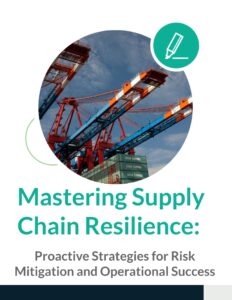As a decision-maker, you’re faced with a plethora of risks that could impact your organization. From financial uncertainties to operational mishaps, having a robust risk management strategy is crucial. This blog post aims to equip you with essential tools and actionable tips for mitigating risks effectively. By the end of this article, you’ll have a comprehensive understanding of how to manage risks in your organizationchc, ensuring business continuity and long-term success.
In some of our recent articles, we’ve delved into various types of risks and their significant impact on your business operations, from financial uncertainties to market fluctuations and competitive challenges. Understanding these risks is crucial for any business leader. Now, I want to equip you with some practical tools and valuable tips to help you initiate meaningful change within your organization. By implementing these strategies, you can proactively manage risks and position your business for long-term success and resilience in an ever-evolving landscape. Let’s explore how to get started on this transformative journey together.
Essential Risk Management Tools
Choosing the right tools to manage risk is crucial for any decision-maker, as effective risk management can significantly impact an organization’s success and sustainability. Here are some of the most effective tools available that can help navigate potential pitfalls:
Risk Assessment Matrix
A risk assessment matrix is a visual tool that helps organizations prioritize risks based on their severity and likelihood of occurrence. By categorizing risks into different levels—such as low, medium, and high—this tool enables decision-makers to allocate resources efficiently and focus on the most critical threats that may impact the organization. Utilizing a risk assessment matrix not only aids in identifying potential risks but also fosters a proactive approach to risk management, allowing teams to devise strategies to mitigate those risks before they escalate.
SWOT Analysis
SWOT analysis, which stands for Strengths, Weaknesses, Opportunities, and Threats, is a comprehensive strategic planning technique that helps organizations identify both internal and external factors that can affect their operations. By examining strengths and weaknesses, organizations can leverage their capabilities while addressing areas for improvement. Simultaneously, evaluating opportunities and threats provides insights into the external landscape, helping decision-makers anticipate risks that may arise from market changes, competitive dynamics, or regulatory shifts. This tool is invaluable for understanding where your business stands and what risks you might face, ultimately guiding informed decision-making and strategic planning.
Risk Register
A risk register is a comprehensive document or risk register software that lists all identified risks, their severity, and the actions taken to mitigate them. This living repository serves as a central location, a single source of truth for risk management efforts, providing a clear overview of the organization’s risk landscape. Keeping a risk register updated ensures that no risks are overlooked and allows teams to track the effectiveness of their mitigation strategies over time. Moreover, reviewing the risk register regularly can facilitate communication among stakeholders, ensuring that everyone is aware of potential risks and the measures in place to address them. By maintaining an accurate and comprehensive risk register, organizations can enhance their ability to respond swiftly to emerging threats and capitalize on opportunities for improvement.
Implementing Risk Management Software
Incorporating technology into risk management can significantly streamline processes, enhance accuracy, and offer valuable insights for organizations of all sizes. By leveraging advanced software solutions, companies can better identify, assess, and respond to risks. Here are some software solutions that can help:
ERM Software
Enterprise Risk Management (ERM) software provides a centralized platform for monitoring and managing risks across an organization. This type of software allows organizations to gain a comprehensive view of their risk landscape, offering real-time updates and detailed analytics. With features such as customizable dashboards and reporting tools, decision-makers can easily track key risk indicators and ensure that they are well-informed when making strategic choices.
GRC Software
Governance, Risk, and Compliance (GRC) software integrates risk management with compliance and governance activities. This holistic approach ensures that all aspects of risk are covered while aligning with regulatory requirements and organizational policies. By facilitating collaboration between different departments, GRC software helps organizations maintain a consistent and proactive stance on risk management, ultimately fostering accountability and transparency.
Predictive Analytics Tools
Predictive analytics tools leverage historical data and advanced algorithms to forecast potential risks, allowing businesses to take proactive measures before issues arise. By analyzing trends and patterns, these tools enable organizations to anticipate challenges and adjust their strategies accordingly. In particular, predictive analytics can be invaluable for financial risk management, helping firms identify vulnerabilities in their portfolios and make informed investment decisions.
Best Practices for Risk Mitigation
Effective risk mitigation requires more than just tools; it involves best practices that ensure comprehensive protection and resilience. By adopting these strategies, organizations can better position themselves to handle potential risks.
Regular Risk Assessments
Conducting regular risk assessments is essential for keeping your risk management plan up-to-date and relevant. This practice involves systematically identifying potential risks, evaluating their impact, and prioritizing them based on likelihood and severity. By doing so, organizations ensure that new risks are identified and managed promptly, facilitating a dynamic risk management process that evolves with changing circumstances.
Employee Training
Educating employees about risk management is crucial for fostering a culture of awareness and preparedness. When staff are well-informed about potential risks, understand the procedures for mitigating them, and know how to respond in various situations, they become an integral part of your risk mitigation strategy. Regular training sessions, workshops, and simulations can empower employees and help them recognize their role in safeguarding the organization.
Creating a Risk-Aware Culture
Fostering a risk-aware culture within your organization encourages proactive risk management at all levels. When everyone understands the importance of managing risks, it becomes a collective effort that transcends departmental boundaries. This culture can be nurtured through open communication, regular updates on risk management initiatives, and encouraging employees to share their insights and concerns. By promoting a shared sense of responsibility, organizations can enhance their resilience and adaptability in the face of uncertainty.
How to Create an Effective Risk Management Plan
A well-structured risk management plan is the backbone of any risk mitigation strategy, ensuring that your organization can navigate uncertainties with confidence. Here’s a detailed guide on how to create one:
Identifying Risks
Start by identifying all potential risks that could affect your organization. This can range from financial uncertainties and operational challenges to external threats like natural disasters or cyberattacks. Utilize tools such as SWOT analysis (Strengths, Weaknesses, Opportunities, Threats) and risk assessment matrices to ensure comprehensive coverage. Engaging with team members from various departments can also provide diverse perspectives on potential risks.
Assessing Risks
Once risks are identified, assess their impact and likelihood. Categorize risks based on their severity and the probability of occurrence. This step helps prioritize risks, enabling you to focus on those that pose the greatest threat to your organization. Using quantitative measures, such as scoring systems, can assist in evaluating and comparing risks effectively.
Developing Mitigation Strategies
Develop tailored strategies to mitigate each identified risk. This could involve implementing new policies, investing in technology, enhancing training for employees, or creating detailed contingency plans that outline specific actions to take in the event of a risk materializing. Regularly review and update these strategies to adapt to new developments and ensure they remain effective over time.
By following these steps, you can create a robust risk management plan that not only protects your organization but also promotes a proactive approach to potential challenges.
Common Pitfalls in Risk Management
While having a risk management plan is essential for the sustainability and growth of an organization, there are several common pitfalls that teams must actively work to avoid:
Ignoring Emerging Risks
The business environment is constantly evolving, with new technologies, market dynamics, and global events creating new risks that can emerge rapidly. Ignoring these emerging risks can leave your organization vulnerable and unprepared for potential threats. For instance, advancements in technology may introduce cybersecurity threats that weren’t previously considered. To mitigate this, organizations should regularly review their risk landscape and adapt their strategies to account for new developments.
Lack of Employee Involvement
Risk management should be viewed as a collective effort that involves all levels of an organization. Failing to engage employees—from frontline staff to executives—can result in overlooked risks and inadequate responses to potential threats. When employees are included in the risk management process, they are more likely to identify risks based on their experiences and provide valuable insights that can enhance the overall strategy. Encouraging a culture of open communication about risks can empower employees to participate actively.
Inadequate Monitoring
Regular and comprehensive monitoring is crucial for effective risk management. Without consistent oversight, your risk management plan can quickly become outdated and ineffective. Organizations should implement a systematic approach to monitor risks, ensuring that changes in the internal and external environment are assessed promptly. Utilizing technology and data analytics can help in identifying trends and potential risks that require immediate attention.
The Role of Leadership in Risk Management
Leadership plays a critical role in the success and effectiveness of risk management strategies. Here’s how leaders can make a significant difference:
Setting the Tone
Leaders have the responsibility to set the tone for risk management within an organization. By prioritizing risk management in their strategic vision and daily operations, they encourage a culture that values risk awareness and proactive measures. This involves not just talking about risk management during meetings but also integrating it into decision-making processes at all levels.
Allocating Resources
Effective risk management requires adequate resources, including time, budget, and personnel. Leaders must ensure that sufficient resources are allocated to risk management activities, such as training programs, risk assessment tools, and cross-departmental collaborations. By investing in these areas, leaders demonstrate their commitment to minimizing risks and enhancing organizational resilience.
Leading by Example
Leaders who practice what they preach inspire their teams to follow suit. By actively participating in risk management initiatives, attending training sessions, and openly discussing risks and challenges, leaders can motivate their teams to engage with the process. This not only fosters a sense of accountability but also helps to create a more resilient organization that is better equipped to handle uncertainties.
Future Trends in Risk Management
Staying ahead of the curve is crucial in risk management, especially as the landscape continues to evolve rapidly. Organizations must be proactive to effectively navigate the challenges ahead. Here are some future trends to watch:
Artificial Intelligence in Risk Management
Artificial Intelligence is revolutionizing the way organizations approach risk management. By leveraging advanced algorithms and machine learning, AI provides significantly more accurate risk assessments and predictive analytics. This technology not only helps in identifying potential risks more effectively but also enables organizations to simulate various scenarios and understand the potential impact of different risk factors. As AI continues to advance, we can expect even more sophisticated capabilities that will empower organizations to make data-driven decisions and improve their overall risk management strategies.
Increased Focus on Cybersecurity
With the rapid rise of digital transformation across industries, cybersecurity risks are becoming increasingly prevalent and complex. Organizations are now more reliant on digital infrastructure, making them more vulnerable to cyber threats such as data breaches and ransomware attacks. Future risk management strategies will need to prioritize cybersecurity measures, ensuring that robust security protocols are in place to protect sensitive data and maintain trust with stakeholders. This includes regular assessments of security practices, investment in new technologies, and employee training to foster a culture of cybersecurity awareness.
Integrating Sustainability
Sustainability is emerging as a critical focus area for many organizations, driven by consumer demand and regulatory pressures. Integrating sustainability into risk management not only addresses environmental and social risks but also enhances an organization’s reputation and long-term viability. By considering sustainability factors, organizations can identify potential risks associated with environmental impact, resource scarcity, and social responsibility. This holistic approach ensures that businesses are prepared for future challenges and can contribute positively to society while mitigating risks.
By keeping an eye on these trends, organizations can enhance their risk management practices and better prepare for the uncertainties of the future.
Conclusion
Effective risk management is essential for the success and longevity of any organization. By understanding the different types of risks, using the right tools, and implementing best practices, decision-makers can protect their organizations from potential threats. Remember, risk management is not a one-time task but an ongoing process that requires regular updates and continuous improvement.
Ready to take your risk management strategy to the next level? Connect with one of our experts today.







